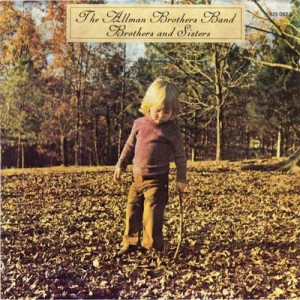The Allman Brothers Band – Circular magazine
Brothers and Sisters Album Ambles On In
Mike Hyland, Capricorn Records national publicity head, is glad that Brothers and Sisters is finished. Now that it’s on the stands a full year after its initial release date (under the fallacious title of Lightnin’ Rod), Mike will no longer have to spend his Macon days explaining to everyone from The Peoria Street Press to The New York Times why the new Allman Brothers Band album has been delayed another few weeks.
“We’ve had the jackets printed and just sitting there waiting for a long time. As soon as the record was finished, we had it pressed and slipped into the jackets in no time flat. Sheesh,” he heaves a sigh of burdenless relief, “I feel like a new man again.”
So, you undoubtedly inquire, why was Brothers and Sisters so long in the making? Lead guitarist Richard (it’s no longer Dicky) Betts answered the big question himself several months ago. “We’re just trying not to rush it,” he said. “We hate to get in there with a deadline and have to force the tunes together. For the first time in a long while, we’re just make for just taking it easy.”
Successful formula
It was mid-1972 when the Allman Brothers Band first shuffled into Macon’s by now famous Capricorn Sound Studios to begin work on their fifth (sixth, counting the Beginnings repackage) album. With co-producer Johnny Sandlin looking on, the group jammed the initial week of sessions, readying themselves for their first total studio effort since Idlewild South, their second LP.
“Our tunes,” Richard explains, “will come when Gregg and I write them at home or somewhere like that. We don’t write too many in the studio. We arrange them there though. We bring in the main body of the tunes and everybody contributes their arrangement ideas. That’s the way we’ve always worked it.” Betts pauses a moment, then adds in afterthought, “It’s worked pretty good too.”
Co-producer Johnny Sandlin, who doubles as the in-house objective opinion, describes the album’s recording. “The band learned most of the songs in the studio. We would try three or four takes… Maybe even six a night. If it didn’t happen, everyone would quit and come back the next night to give it another try. When the take finally happened, it would be spontaneous. It wouldn’t be from 24 hours of straight-ahead drilling in the studio. It may have taken ten days to finish one song, but it was definitely worth it.
“The basic track for each song was 85 to 90% the complete tune. The only overdubbing was percussion parts like congas, tambourines and maracas. There is no essential instrument over-dubbed, except vocals.”
A look over the tracks on Brothers and Sisters shows the absence of one cut, whose inclusion was in emphatically announced last February. “Berry’s Tune,” a sizzling studio jam featuring the late ABB bassist Berry Oakley, was eventually x-ed from the album.
“We have the cut,” says Sandlin, “and it’s very interesting. The reason we didn’t put it on this album is that it is a jam, and after the long wait, we just didn’t want people to feel they were getting ripped-off. It lasts about ten minutes, which is fairly long. There’ll be a time to put it out. It’s certainly worthy of it.”
Once matters returned to a relatively tranquil state after the death of Berry Oakley and the additions of new members Chuck Leavell and Lamar Williams, the completion of Brothers and Sisters was entirely up to the schedule of the band members. Getting everyone together in the same studio is no easy task. “It was really a matter of getting the right people in the right place at the right time,” says Chuck Leavell. “Several of us were doing different things – for instance, the Indian Benefit thing that Richard has been working on. Sometimes he got so involved that he had to miss a session. And Gregg had his own album going. If everybody wasn’t there… we just couldn’t do anything for a night.”
Pure Rock & Roll
“The album is different than the others,” Sandlin relates. “A lot of it is pure rock & roll, versus the blues-rock of the past. ‘Jessica’ is about the only tune that does carry on the tradition. ‘Pony Boy’ however, is quite different from anything the band has ever recorded before. It’s a soft, acoustic song.
“It’s a positive record. Many of the songs are in major keys, where before the songs were mostly minors. It’s just an up type of thing. The whole album.”
With the long anticipated Brothers and Sisters behind them, rest assured it won’t be nearly as long a wait until the next ABB album. A triple-LP live package, due out in December, features both The Grateful Dead and the Allman Brothers Band. Proceeds from the album, recorded at the July 28 Watkins Glen Festival in New York, are tentatively earmarked for the American Indians. In preparation for the big event, the ABB recorded the set at their recent appearance in Washington’s RFK Stadium.
“We got some nice things,” beams Sandlin. “Some of the songs are tunes that have been on other live albums, but they’re all quite different, with the new band and all. I’m just knocked out. Right now, these guys are playing as well as the Allman Brothers Band ever has.”
Courtesy of Circular – Cameron Crowe – August 6, 1973


